This post contains affiliate links. We may get paid an affiliate commission if you buy something or take an action after clicking one of the links on this web page.
Last Updated: July 27, 2019
The KA-BAR website tends to be pretty laconic with its product descriptions in general, but the terse, colorless description they provide for the KA-BAR Dozier Folding Hunter would make the editor of technical manuals nod off mid-sentence:
“Award-winning lock back designed by Bob Dozier is an affordable, practical all-purpose knife appropriate for daily tasks. Features a reversible pocket clip and thumb stud.”
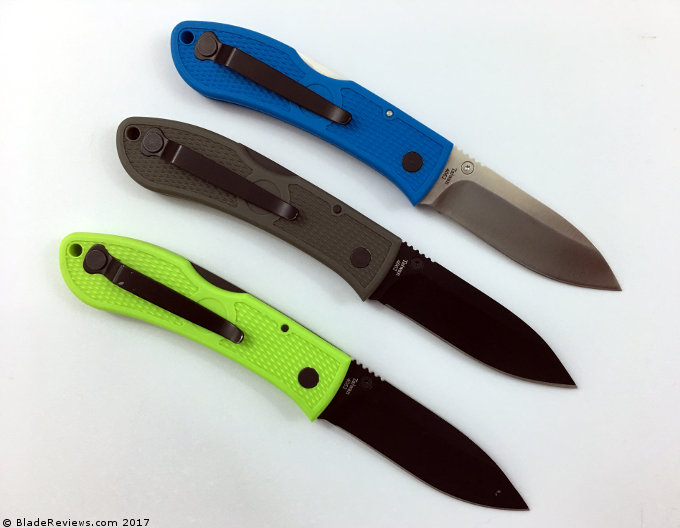
Buy the Ka-Bar Dozier Folding Hunter at BladeHQ
I can certainly sympathize with the KA-BAR copy editor. On a superficial level, what is there to say about the simple Dozier Folding Hunter? It was originally released in 2003, and as far as I can tell it has hardly changed at all since then, submerged in the nearly-empty waters of the sub-$20 big brand knife bracket like one of those ancient fish that have kept their prehistoric forms for millions of years.
On the other hand, such longevity without change is virtually unheard of, especially in the budget realm, where we’ve already forgotten that the Spyderco Tenacious used to be the absolute cutting edge under $40 just a few years ago. Like the Tenacious, the Dozier won Best Buy at Blade Show the year it released. Unlike the Tenacious, the Dozier remains relatively unchallenged at its price point. It’s still one of the original freaks of the knife world, a sui generis offering that nothing much really directly compares with.
It was a knife I have been meaning to try out for a long time. So I picked up a trio of Dozier Folding Hunters to see what there was to see. Is it still a watermark in the budget realm, or a fossil from a different age? Let’s take a closer look.
General Dimensions and Blade Details
The Dozier has a blade length of 3”, a handle of 4-3/16”, and an overall length of 7-1/4”. It weighs 2.4 oz and is made in Taiwan. There is a smaller Dozier but I think the full-size model is the one you should go with. It still weighs nothing and you get a jump up in utility with the increased blade size.
A fit and finish note: while general fit and finish was good across all three Doziers I purchased, there was some variance between the blades grinds. The blue one fared the worst, with a noticeable recurve. The olive green sample was better, albeit with an uneven edge grind – the sharpened edge goes down farther on side than the other. Leslie’s Zombie Green model was far and away the winner, with a truer edge and clean, consistent grind.
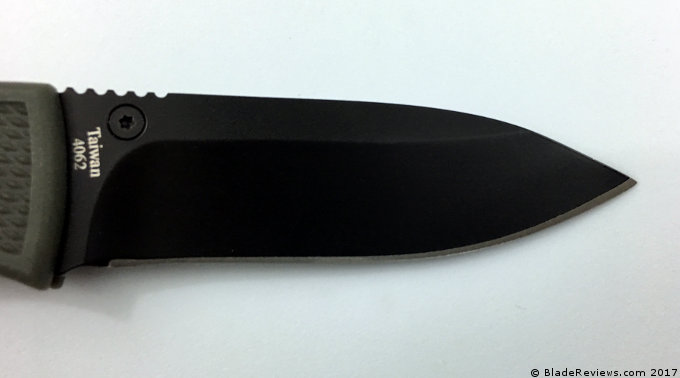
I don’t like playing the “What do you expect for $20” card because, even when I shell out $20, I expect a good knife made to consistent quality standards. So it’s definitely a mark against this knife that there is so much variance here. However, I would be fibbing if I said it made the slightest bit of difference in cutting or sharpening.
Depending on where you go this model’s blade is called a “spear” in some places, a “hunter” elsewhere, and a “drop point” in still others. Hairsplitting aside, it’s a great blade shape; there’s not much you can’t do with it, and the 3” length is just right. It’s also another exhibit in the case for hollow grinds in mid-size blades: I think they perform better overall, especially outside of food prep tasks. Even with a fairly narrow blade profile, the Dozier zips through material effortlessly.
It’s easy to get repetitive in describing steels, but to be brief: AUS-8 is just great. Highly corrosion resistant, easy to sharpen, and offering good edge retention, I think it is demonstrably better than 8Cr13MoV. It’s the perfect steel for a first-time knife user or for someone who doesn’t really care about knives and just needs something that will work for a long time. One of these Doziers went to work with my girlfriend every day and she appreciated that it held up well to regular use. Even for us enthusiasts it holds plenty of appeal.
Handle, Ergonomics, and Pocket Clip
The Dozier’s handle is stripped of all embellishment. A simple bow shape, designed to accommodate the curvature of the human hand. Construction is equally simple, a two-piece Zytel build, with the partial backspacer integral to the off-side scale. Diamond texturing molded into the Zytel imparts a decent amount of grippiness here.
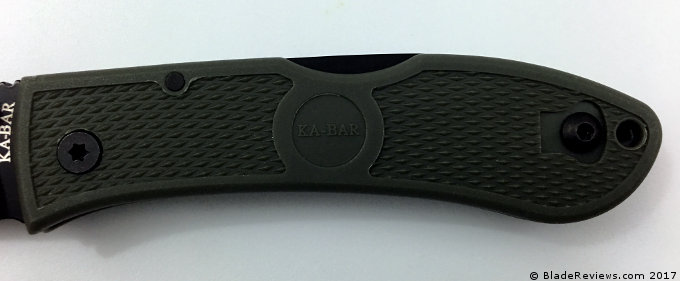
The handle’s simplicity works in its favor. One issue with ergonomic details like finger choils is that they always mean the knife favors a certain grip. Even a wonderfully comfortable knife like the Strider PT CC works better in the forward grip than in reverse or pinch grips because of its famous double finger grooves. The Dozier’s simplicity may not be as immediately gratifying, but it is never problematic, never less than accommodating. Try and find an uncomfortable grip on this knife: if you manage to do so, you’re probably holding it by the blade.
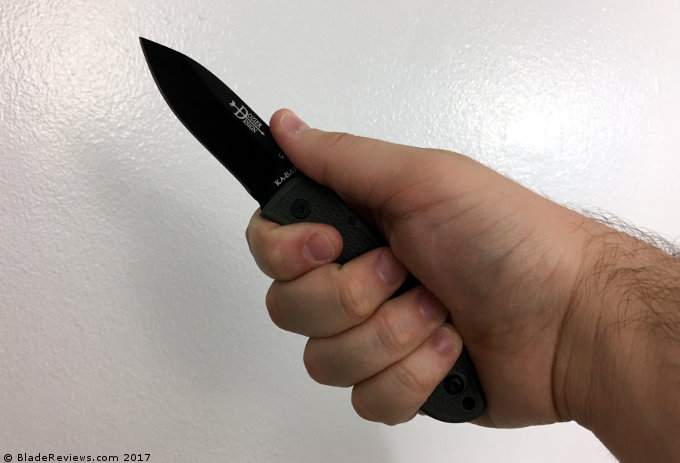
The reversible pocket clip is long and slender, and recessed into the handle like a Sebenza clip – a nice detail because it prevents side-to-side wiggle. Although thin, it is made from a fairly thick piece of steel – mostly a good thing as it is extra durable, but it does mean that retention is pretty tight. Things should loosen up over time (and thankfully the clip’s retention point is on a non-textured surface in the center of the handle), but even out of the box, it’s far from unusable. The knife itself is nice and thin in addition to being lightweight – an easy carry in almost all circumstances.
Deployment and Lockup
For deployment the Dozier utilizes a single, reversible thumb stud. I’ve always like the single thumb stud idea – just seems like a more efficient use of material, which of course is in keeping with the generally efficient, streamlined design of this knife.
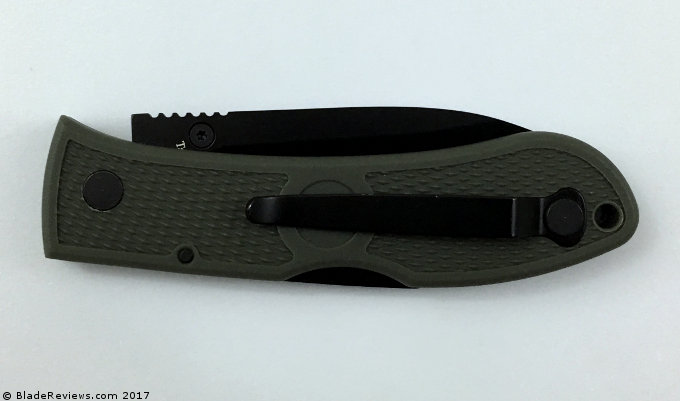
As with any lockback there’s friction during deployment, but the blade can be flicked out or slow rolled with relative ease after a little break-in. One interesting element of the Dozier is the complete absence of washers or bearings: instead, the blade pivots on raised, washer-shaped areas of Zytel. Even with this rudimentary construction, the primary sensation during opening is one of smoothness. This was consistent across all three review samples.
The Dozier’s lockback has some definite spring to it. It snaps into an open position and disengages with an audible pop. Lockup is sound: there’s no side-to-side play, although a slight up and down movement can be detected. Almost all lockbacks I’ve owned exhibit this to greater or lesser degrees so I’m not worried about it. I’m confident in saying that the Dozier could withstand a fair bit of hard cutting before you’d notice any issues with the lock. And along with the clip and thumb stud, it means the Dozier is 100% ambidextrous.
KA-BAR Dozier Folding Hunter Review – Final Thoughts
The Dozier is a knife from a different age. It predates our modern obsessions with lock types, flipping action, celebrity designers (Bob Dozier may be a legend but his name doesn’t have the current cachet of a Jesse Jarosz or Rick Hinderer) and all other knife nerd fallalery. There’s nothing wrong with enjoying these things, but there’s something bracing about carrying a knife that ignores so much of them and still functions so well. It’s a real tonic for today’s overexposed, oversaturated, overanalyzed knife world.
After fourteen years on the market, the Dozier is still one of the best deals around. It makes no real compromises and has no real weaknesses other than a lack of visual appeal. An enthusiast would never want this to be his only blade, but realistically it does all that you should ask of a folding knife. It won’t be my last knife – and it won’t be yours – but it could be if we ever shake the knife collecting bug.
- AUS 8 stainless steel blade
- Designed by Bob Dozier
- Dual thumb studs for quick deployment
- Reversible pocket clip
Editor: I recommend purchasing the Ka-Bar Dozier Folding Hunter at Amazon or BladeHQ. Please consider that purchasing anything through any of the links on this website helps support BladeReviews.com, and keeps the site going. As always, any and all support is greatly appreciated. Thank you very much.
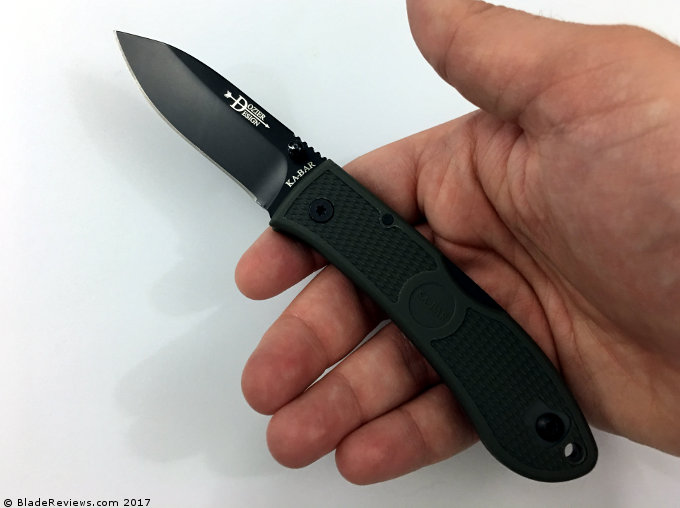

Good review! I didn’t know it’s been around so long. I’ve had one for 2 or 3 years and have really enjoyed it. It was intentionally purchased to use when I didn’t want to hurt one of my better knives. At ~$20 I don’t mind abusing it, and it re-sharpens so easily it doesn’t bother me to cut or scrape stuff that may damage the edge. The coating on the blade was the biggest drawback, scratching and peeling like paint (which I think it is). I deliberately removed it all, and it looks better without it. AUS-8 doesn’t really need help against corrosion anyway. Considering the construction, it probably isn’t a “hard use” folder for extreme applications; but it is (as you said) an excellent EDC option. I often clip it in the waistband of my athletic shorts when hiking or working outside, since it’s light and not bothered by sweat.
Hey John,
Thanks for reading!
AUS-8 is the perfect beater steel – much more likely to roll than chip, and simple to bring back after it does. The coating (definitely paint) didn’t bother me too much. I don’t normally go in for coating blades so I figured I’d give it a shot on this one. But the satin finish looks better, now doubt, and if someone likes the handle color of a coated blade model removing the paint shouldn’t be too hard.
Agreed on the weight – it’s been a particularly hot summer here and the Dozier is a great blade for outdoor summer activity. Doesn’t way you down and isn’t fazed by the elements.
Ben.
Thanks for the reply! I was just looking, and the most comparable competition seems to be the ESEE Zancudo and Ontario RAT 2, both at $30 with the same steel. Do you feel there are noticeable advantages in use with either of those? I haven’t ever used either, but have often thought about adding one of them to my budget collection and wonder how they compare. Any experience with them?
Best,
John
Hey John,
I have experience with the Zancudo – I’ve owned it for several years and, while it is a good knife, it never really did it for me. The clip is bad and the plastic handle scale feels weird. I can’t argue with the blade shape, steel choice, or construction, but I will never carry mine again in all likelihood. It just lacks a spark, if that makes sense.
As for the RAT 2, I haven’t handled one but it gets a lot of rave reviews, as does its bigger brother. I’ve always admired the design. Without having carried one myself I can’t say for sure but it seems like a safe bet, and between these two knives would be my choice for sure.
Another knife around this price that I really enjoy is the Ontario Utilitac II. This is a much bigger knife but it’s a lot of fun on top of being a great blade on a budget. The Drifter would be another good choice but unfortunately takes a hit in the steel department (8Cr14MoV vs. AUS-8).
Ben.
There’s several brands that produce quality made budget folders under $30 and the quality is on par,if not better,than Kabar’s Dozier folders.Just off the top of my head,and from what i own,there’s any number of Kershaw’s 8cr13mov folders,Spyderco’s”Byrd” line,a few CRKT,Buck’s US made Bantam and Vantage line in Bos treated 420hc which is a good budget steel,not to mention Camillus has several folders in Aus8 steel that are worth checking out.To be honest,if i was looking to spend $30 on a folder,i would just spend an xtra $10 and grab a D2 version of the RAT 1..D2 steel holds it’s edge much longer than Aus8 or any other budget/inexpensive steel,all things being equal..It’s not even close..The D2 RAT 1 from Ontario is in my opinion THE BEST budget folder available today..
Hey Adams,
Definitely – once you go up over $20 the competition really opens up. The 8Cr Kershaws aren’t really doing it for me these days but I’m sure there’s a few good ones in the lineup, and Camillus is a brand that I haven’t had a chance to check out – but if they’re putting out AUS-8 under $30 that’s definitely worth looking into.
The Bantams are probably the closest direct comparison here as I think they go for $15-$20 depending on what flavor you get. But, for me, 420HC is just not good enough. Even with the Bos heat treat I find its performance sub-par. I do like the Bantam anyway though, and have always wanted to pick one up. It’s also worth pointing out that the new for 2017 Rival series falls into this same price bracket and has the same materials as the Bantams.
The D2 Rat 1 is without a doubt tough to beat, and I bet it’s only a matter of time before the Rat 2 gets the D2 treatment as well. For me, I like the improved stain-resistance of AUS-8 and am willing to trade some edge retention for that because rust drives me absolutely up a wall.
Thanks for the recommendations, lots of awesome info here.
Ben.
You gotta be plum crazy if you think Kershaw 8cr is better than the Dozier/Kabar folder in Aus8. As far as the Rats go I hate em. in one year I had 2 lose their ability to lock from the liner lock grinding into the back meeting point of the blade causing a grinded blade area with an angle that eventually led to premature blade closings. Don’t believe me? Spine whack the back of your Rat that has seen decent use for a good 6 months on your pants leg 4 or 5 times and see what happens. The Kabar/Dozier wins hands down.